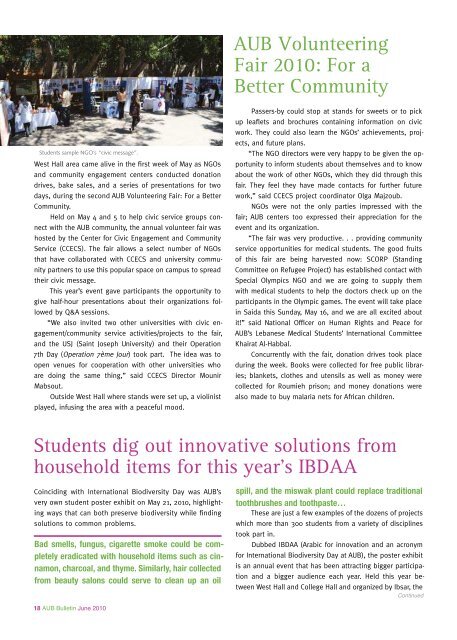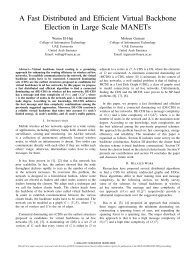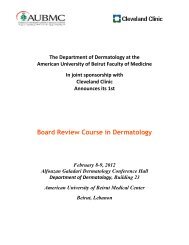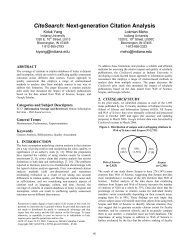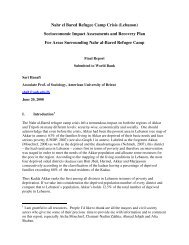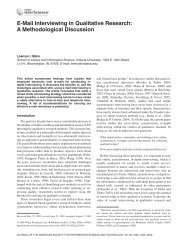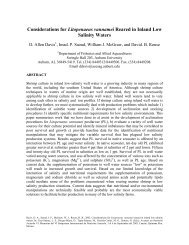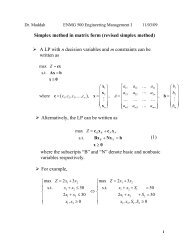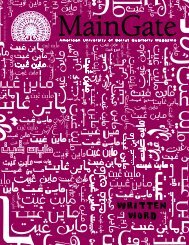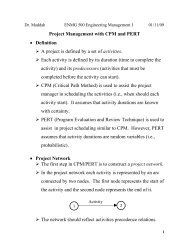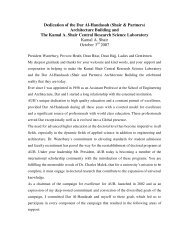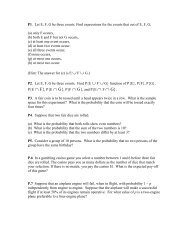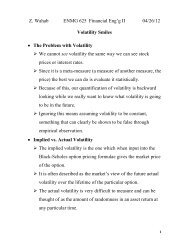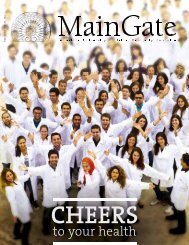Bulletin - American University of Beirut
Bulletin - American University of Beirut
Bulletin - American University of Beirut
Create successful ePaper yourself
Turn your PDF publications into a flip-book with our unique Google optimized e-Paper software.
Students sample NGO’s “civic message”.<br />
West Hall area came alive in the first week <strong>of</strong> May as NGOs<br />
and community engagement centers conducted donation<br />
drives, bake sales, and a series <strong>of</strong> presentations for two<br />
days, during the second AUB Volunteering Fair: For a Better<br />
Community.<br />
Held on May 4 and 5 to help civic service groups connect<br />
with the AUB community, the annual volunteer fair was<br />
hosted by the Center for Civic Engagement and Community<br />
Service (CCECS). The fair allows a select number <strong>of</strong> NGOs<br />
that have collaborated with CCECS and university community<br />
partners to use this popular space on campus to spread<br />
their civic message.<br />
This year’s event gave participants the opportunity to<br />
give half-hour presentations about their organizations followed<br />
by Q&A sessions.<br />
“We also invited two other universities with civic engagement/community<br />
service activities/projects to the fair,<br />
and the USJ (Saint Joseph <strong>University</strong>) and their Operation<br />
7th Day (Operation 7ème Jour) took part. The idea was to<br />
open venues for cooperation with other universities who<br />
are doing the same thing,” said CCECS Director Mounir<br />
Mabsout.<br />
Outside West Hall where stands were set up, a violinist<br />
played, infusing the area with a peaceful mood.<br />
AUB Volunteering<br />
Fair 2010: For a<br />
Better Community<br />
Passers-by could stop at stands for sweets or to pick<br />
up leaflets and brochures containing information on civic<br />
work. They could also learn the NGOs’ achievements, projects,<br />
and future plans.<br />
“The NGO directors were very happy to be given the opportunity<br />
to inform students about themselves and to know<br />
about the work <strong>of</strong> other NGOs, which they did through this<br />
fair. They feel they have made contacts for further future<br />
work,” said CCECS project coordinator Olga Majzoub.<br />
NGOs were not the only parties impressed with the<br />
fair; AUB centers too expressed their appreciation for the<br />
event and its organization.<br />
“The fair was very productive. . . providing community<br />
service opportunities for medical students. The good fruits<br />
<strong>of</strong> this fair are being harvested now: SCORP (Standing<br />
Committee on Refugee Project) has established contact with<br />
Special Olympics NGO and we are going to supply them<br />
with medical students to help the doctors check up on the<br />
participants in the Olympic games. The event will take place<br />
in Saida this Sunday, May 16, and we are all excited about<br />
it!” said National Officer on Human Rights and Peace for<br />
AUB’s Lebanese Medical Students’ International Committee<br />
Khairat Al-Habbal.<br />
Concurrently with the fair, donation drives took place<br />
during the week. Books were collected for free public libraries;<br />
blankets, clothes and utensils as well as money were<br />
collected for Roumieh prison; and money donations were<br />
also made to buy malaria nets for African children.<br />
Students dig out innovative solutions from<br />
household items for this year’s IBDAA<br />
Coinciding with International Biodiversity Day was AUB’s<br />
very own student poster exhibit on May 21, 2010, highlighting<br />
ways that can both preserve biodiversity while finding<br />
solutions to common problems.<br />
Bad smells, fungus, cigarette smoke could be completely<br />
eradicated with household items such as cinnamon,<br />
charcoal, and thyme. Similarly, hair collected<br />
from beauty salons could serve to clean up an oil<br />
spill, and the miswak plant could replace traditional<br />
toothbrushes and toothpaste…<br />
These are just a few examples <strong>of</strong> the dozens <strong>of</strong> projects<br />
which more than 300 students from a variety <strong>of</strong> disciplines<br />
took part in.<br />
Dubbed IBDAA (Arabic for innovation and an acronym<br />
for International Biodiversity Day at AUB), the poster exhibit<br />
is an annual event that has been attracting bigger participation<br />
and a bigger audience each year. Held this year between<br />
West Hall and College Hall and organized by Ibsar, the<br />
Continued<br />
Teaching about nature and helping students appreciate its value.<br />
Nature Conservation Center for Sustainable Futures at AUB,<br />
the exhibition aimed to teach students about nature and<br />
help them appreciate its value by learning “how to perceive<br />
it, how to conserve it, and how to use it sustainably.”<br />
Participants consisted <strong>of</strong> students from several science<br />
and non-science courses, including chemistry, biology,<br />
Technology in the Classroom<br />
Those who experiment with technology in teaching “are all<br />
pioneers,” Provost Ahmad Dallal told participants at the<br />
Academic Computing Center’s Eighth Faculty Seminar on<br />
Teaching and Learning with Technology. “You are leading<br />
us,” he added, thanking all those going out <strong>of</strong> their way to<br />
put knowledge <strong>of</strong> technology into teaching and learning. In<br />
the future, he said, increased emphasis will be placed on<br />
essential classroom technologies. “All universities,” Dallal<br />
said, “are moving in this direction.”<br />
Provost Dallal’s remarks came at the beginning <strong>of</strong> the<br />
ACC seminar in College Hall on May 26, 2010. AUB is ready,<br />
he insisted, to determine some mechanism for rewarding<br />
technology users for the demanding work involved in inaugurating<br />
technologies in the classroom.<br />
ACC Director Rosangela Silva provided a timeline <strong>of</strong> the<br />
center’s accomplishments since the last seminar in 2009: a<br />
new web site with a virtual faculty lounge, a jump in course/<br />
section use <strong>of</strong> Moodle (AUB’s learning management system)<br />
from 3 to 70 percent, a Moodle server for individuals<br />
outside the <strong>University</strong> (courses <strong>of</strong>fered to National Bank <strong>of</strong><br />
Kuwait and Nissan Gulf), introduction <strong>of</strong> Lime Survey, a free,<br />
user-friendly methodology for students, staff, and faculty to<br />
create surveys on-line; a paper-saving campaign to decrease<br />
unnecessary downloading and printing, and Mahara (expertise<br />
in Arabic), an on-line personal portfolio to be available<br />
at the end <strong>of</strong> summer.<br />
Several AUB teachers from different disciplines described<br />
their experiences with blended learning, a combination <strong>of</strong><br />
face to face (F2F) and on-line teaching: Faculty <strong>of</strong> Health<br />
Sciences Pr<strong>of</strong>essor May Massoud, Sara Khaddaj <strong>of</strong> Electrical<br />
and Computer Engineering, the English Department’s<br />
Zane Sinno, clinical bioethitist Thalia Arawi <strong>of</strong> the Faculty<br />
environmental health and civil engineering, graphic design,<br />
mythology, English, and ceramics. The artistic contributions<br />
from the ceramics course showed some abstract representations<br />
<strong>of</strong> environmental destruction. One work <strong>of</strong> art called<br />
“Nature” consisted <strong>of</strong> three sculptures; one represented the<br />
heart <strong>of</strong> nature with stitched-up scars indicating the damage<br />
inflicted on earth by humans.<br />
Other projects also included a microbiology study<br />
carried out at the Jeita Grotto to show signs that the ecological<br />
balance there has been upset. For instance, there<br />
are already traces <strong>of</strong> E. coli in the caves, probably due to<br />
sewage disposal, and phototrophic bacteria which would<br />
not naturally be found in such a dark environment.<br />
Other students found that adding zero valent iron to<br />
drinking water could neutralize the effects <strong>of</strong> certain harmful<br />
chemicals that might be present.<br />
Dallal: Teaching with technology experimenters «are all pioneers.»<br />
<strong>of</strong> Medicine, and Pr<strong>of</strong>essor Salma Talhouk <strong>of</strong> Landscape<br />
Design and Ecosystem Management. ACC’s Hossein Hamam<br />
described the first 100 percent on-line course <strong>of</strong>fered at AUB<br />
in spring 2009-10 by engineering management Pr<strong>of</strong>essor<br />
Walid Nasrallah in conjunction with the ACC.<br />
The teachers shared similar experiences and highlighted<br />
advantages and disadvantages <strong>of</strong> blended learning<br />
in courses in environmental health, engineering lab, English<br />
for international business, medical ethics, and plant biology.<br />
Almost all found flexibility in time constraints beneficial but<br />
emphasized the enormous amount <strong>of</strong> time necessary for<br />
vital course redesign. All praised the independence, selfconfidence,<br />
and critical thinking generated in students.<br />
One even suggested that the student produced in a<br />
blended learning course resembles the ideal student described<br />
in the <strong>University</strong>’s mission statement. Zane Sinno<br />
said, “Blended learning enhances the venues and possibilities<br />
for a collaborative learning environment both between<br />
students and between teacher and student,” creating a<br />
“‘work-in-progress’ atmosphere in and outside the classroom,<br />
making the course more vibrant and the material more<br />
interesting.”<br />
18 AUB <strong>Bulletin</strong> June 2010 AUB <strong>Bulletin</strong> June 2010 19


